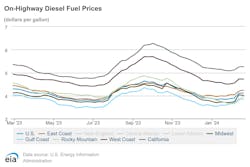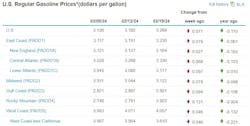The week of Presidents Day saw a plateau in the national average of on-highway diesel fuel costs, accoring to the U.S. Energy Information Administration (EIA). The national average kept its value from last week of $4.109 per gallon, which is 26 cents cheaper than this time last year.
However, this was not the case in every region across the country. In particular, the Rocky Mountain region experienced the highest diesel fuel cost increase of 15 cents, pushing prices to $3.957 per gallon. The Lower Atlantic sub-region saw the next highest price increase of 4 cents, reaching $4.189 per gallon, with the East Coast region as a whole increasing 3 cents to $4.240.
Meanwhile, price decreases, while more prevalent than last week, were also relatively minimal and ranged from 3 cents to less than a cent in total. In this case, the New England sub-region and the Midwest both decreased by 3 cents, with New England’s fuel costs reaching $4.320, while the Midwest hit $4.010 per gallon.
But overall, the Gulf Coast reclaimed its title of the cheapest place to buy gas at $3.844 per gallon, and California is still the most expensive at $5.258 per gallon.
Read more: Diesel, gasoline prices up across the country
In comparison, the AAA motor club logged this week’s national average diesel price at $4.094 per gallon, much closer to the EIA’s numbers. The AAA’s diesel prices also saw an increase of 5 cents since last week. But they’re still not surpassing last year’s average at this time of year, either.
Gasoline prices continue slow and steady rise
Why diesel prices saw a mix of increases and decreases in the last week, gasoline costs rose across the board. Currently, the EIA logged the national gas average at $3.269 per gallon, an increase of 7 cents from a week ago and down 11 cents from the year before.
In general, gasoline’s price increases ranged from 2-13 cents at most. The New England sub-region saw the smallest price increases and landed with gas prices of $3.164 per gallon. The Rocky Mountain region bore the brunt of fuel price increases this week, rising 13 cents to $4.922 per gallon. The Lower Atlantic sub-region saw the second-largest increase in gas prices (9 cents), reaching $3.177 per gallon.
Despite the increase in fuel costs across the country, the Gulf Coast is the cheapest place to purchase gasoline fuel at $2.901 per gallon. Meanwhile, California is the most expensive at $4.467 per gallon.
For context, AAA’s current national gas average is $3.276 per gallon, which is more expensive than last week by 5 cents. But this week’s average is also still 14 cents better than this time last year, too.
According to a press release from the AAA, the organization claimed that part of the reason for increasing gas prices is a BP-Whiting refinery in Indiana which has been shut down for over two weeks due to a power outage. Once the plant is operational again, explained Andrew Gross, AAA spokesperson, “we should see more regular seasonal price increases,” the company stated.
This article was originally published on FleetOwner.com.
About the Author

Alex Keenan
Alex Keenan is an Associate Editor for Fleet Maintenance magazine. She has written on a variety of topics for the past several years and recently joined the transportation industry, reviewing content covering technician challenges and breaking industry news. She holds a bachelor's degree in English from Colorado State University in Fort Collins, Colorado.


